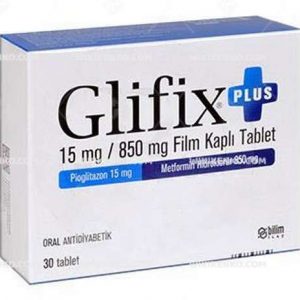Glifix Tablet 30 Mg
In the realm of managing type 2 diabetes mellitus, Glifix Tablet 30 Mg stands as a pivotal oral medication. This article delves into the key aspects of Glifix, from its composition and mechanism of action to its indications, precautions, and potential side effects.
| Dosage form | |
|---|---|
| Pack size | |
| Potency | 30 Mg |
| Manufacturer | |
| Origin | |
| Generic Name (Ingredient) | Each Tablet Contains 33.4 Mg Pioglitazone Hcl Equivalent To 30 Mg Pioglitazone. |
Assuming your emergency circumstances for this product, visit Urgent Quotation page. Besides, for any pharmaceutical questions, please ask us in the comments section.
Description
Understanding Glifix Tablet 30 Mg
Glifix Tablet 30 Mg takes the forefront as an oral antidiabetic medication meticulously designed to address type 2 diabetes mellitus. By effectively regulating blood sugar levels, it plays a crucial role in mitigating the formidable complications that can arise from diabetes, such as kidney damage and blindness.
Exploring the Composition
Each Glifix tablet boasts 30 mg of pioglitazone, equating to 33.4 mg of pioglitazone HCl. This formulation also encompasses various inactive constituents, including lactose monohydrate (sourced from cow’s milk), calcium carboxymethylcellulose, hydroxypropylcellulose, and magnesium stearate.
Applicability and Indications
Glifix earns its place in the medical arsenal as an invaluable treatment for type 2 diabetes mellitus in adults. It can be employed either as a standalone solution or in conjunction with other oral antidiabetic medications when dietary measures alone are insufficient. Additionally, when metformin becomes impractical, Glifix can complement insulin therapy.
Mechanism of Action
The efficacy of Glifix is rooted in its ability to enhance the utilization of the body’s insulin. By bolstering the sensitivity of cells to insulin, glucose absorption is facilitated, effectively controlling blood sugar levels. This mechanism acts as a formidable barrier against the potential complications associated with diabetes.
Dosage and Administration
The dosing regimen for Glifix is customized under the guidance of a healthcare professional and can vary from person to person. Adhering strictly to the instructions given by your doctor is imperative. Typically, the effectiveness of the treatment is evaluated three to six months into its commencement. If the response to the medication is deemed inadequate, discontinuation might be considered.
Contraindications and Precautions
Certain contraindications guide the utilization of Glifix. Individuals with a confirmed allergy to pioglitazone or any of the tablet’s inactive components are advised against its usage. Further contraindications extend to those with heart failure, liver failure, diabetic ketoacidosis, bladder cancer, or a history thereof. Presence of blood in urine also warrants refraining from it.
For those with a history of fluid retention or heart failure, especially among individuals aged 75 and above, it should be approached with caution. Similar consideration applies to those with diabetic eye disease that triggers macular edema.
Side Effects
While Glifix stands as an essential tool for managing type 2 diabetes mellitus, it is not without potential side effects. The most prevalent among these include hypoglycemia, headache, nausea, and dizziness. Recognizing the signs of low blood sugar levels is crucial. Regular meals and carrying a fast-acting glucose source, such as sugary food or fruit juice, are prudent measures to counteract hypoglycemia. Alcohol consumption can heighten the risk of low blood sugar levels and is thus best avoided.
Concluding Thoughts
In sum, Glifix Tablet 30 Mg emerges as a potent ally in the battle against type 2 diabetes mellitus. Its role in regulating blood sugar levels and averting potential complications cannot be understated. Adherence to your healthcare provider’s directives and regular check-ups constitute the cornerstones of a successful Glifix treatment journey.
If you encounter any side effects while on this medication, seeking counsel from your healthcare provider is of paramount importance. Diabetes management requires vigilance and proactive measures, and it is a valuable asset on this journey.
Use the form below to report an error
Please answer the questions as thoroughly and accurately as possible. Your answers will help us better understand what kind of mistakes happen, why and where they happen, and in the end the purpose is to build a better archive to guide researchers and professionals around the world.
The information on this page is not intended to be a substitute for professional medical advice, diagnosis, or treatment. always seek the advice for your physician or another qualified health provider with any questions you may have regarding a medical condition. Always remember to
- Ask your own doctor for medical advice.
- Names, brands, and dosage may differ between countries.
- When not feeling well, or experiencing side effects always contact your own doctor.
Cyberchondria
The truth is that when we’re sick, or worried about getting sick, the internet won’t help.
According to Wikipedia, cyberchondria is a mental disorder consisting in the desire to independently make a diagnosis based on the symptoms of diseases described on Internet sites.
Why you can't look for symptoms on the Internet
If diagnoses could be made simply from a textbook or an article on a website, we would all be doctors and treat ourselves. Nothing can replace the experience and knowledge of specially trained people. As in any field, in medicine there are unscrupulous specialists, differences of opinion, inaccurate diagnoses and incorrect test results.






Reviews
There are no reviews yet.